The Western Digital Black PCIe SSD (512GB) Review
by Billy Tallis on March 8, 2017 8:30 AM ESTATTO
ATTO's Disk Benchmark is a quick and easy freeware tool to measure drive performance across various transfer sizes.
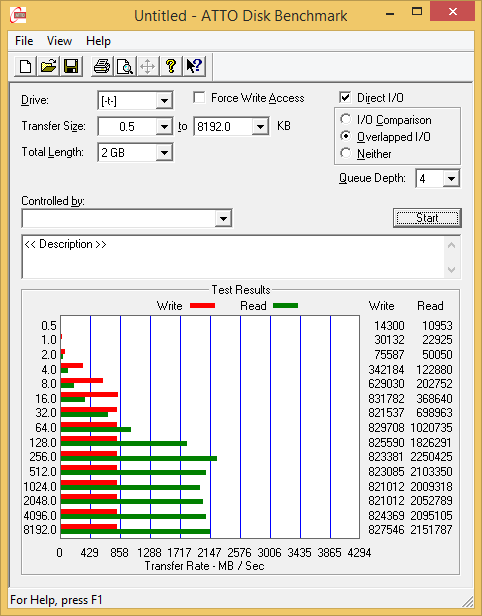 |
|||||||||
During the ATTO benchmark the WD Black's write speed tops out around 830 MB/s for transfers of at least 16kB blocks, while the reads don't reach full speed until the transfers are at least 256kB. This is actually a little bit early, as most PCIe SSDs reach their peak with 512kB or larger transfers.
AS-SSD
AS-SSD is another quick and free benchmark tool. It uses incompressible data for all of its tests, making it an easy way to keep an eye on which drives are relying on transparent data compression. The short duration of the test makes it a decent indicator of peak drive performance.
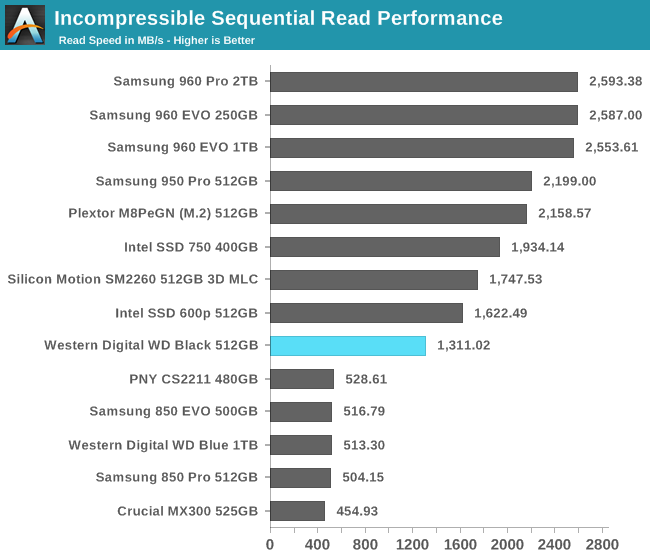
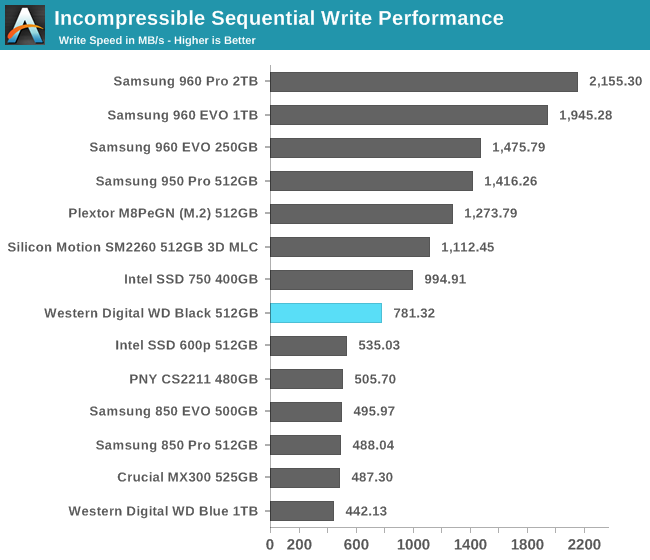
The WD Black actually manages to fall behind the Intel 600p for AS-SSD's sequential read speed test, making it the slowest PCIe SSD but still more than twice as fast as SATA. For write speeds, the Intel 600p barely outperforms SATA SSDs while the WD Black has a comfortable lead.
Idle Power Consumption
Since the ATSB tests based on real-world usage cut idle times short to 25ms, their power consumption scores paint an inaccurate picture of the relative suitability of drives for mobile use. During real-world client use, a solid state drive will spend far more time idle than actively processing commands.
There are two main ways that a NVMe SSD can save power when idle. The first is through suspending the PCIe link through the Active State Power Management (ASPM) mechanism, analogous to the SATA Link Power Management mechanism. Both define two power saving modes: an intermediate power saving mode with strict wake-up latency requirements (eg. 10µs for SATA "Partial" state) and a deeper state with looser wake-up requirements (eg. 10ms for SATA "Slumber" state). SATA Link Power Management is supported by almost all SSDs and host systems, though it is commonly off by default for desktops. PCIe ASPM support on the other hand is a minefield and it is common to encounter devices that do not implement it or implement it incorrectly. Forcing PCIe ASPM on for a system that defaults to disabling it may lead to the system locking up; this is the case for our current SSD testbed and thus we are unable to measure the effect of PCIe ASPM on SSD idle power.
The NVMe standard also defines a drive power management mechanism that is separate from PCIe link power management. The SSD can define up to 32 different power states and inform the host of the time taken to enter and exit these states. Some of these power states can be operational states where the drive continues to perform I/O with a restricted power budget, while others are non-operational idle states. The host system can either directly set these power states, or it can declare rules for which power states the drive may autonomously transition to after being idle for different lengths of time. NVMe power management including Autonomous Power State Transition (APST) fortunately does not depend on motherboard support the way PCIe ASPM does, so it should eventually reach the same widespread availability that SATA Link Power Management enjoys.
We report two idle power values for each drive: an active idle measurement taken with none of the above power management states engaged, and an idle power measurement with either SATA LPM Slumber state or the lowest-power NVMe non-operational power state, if supported.
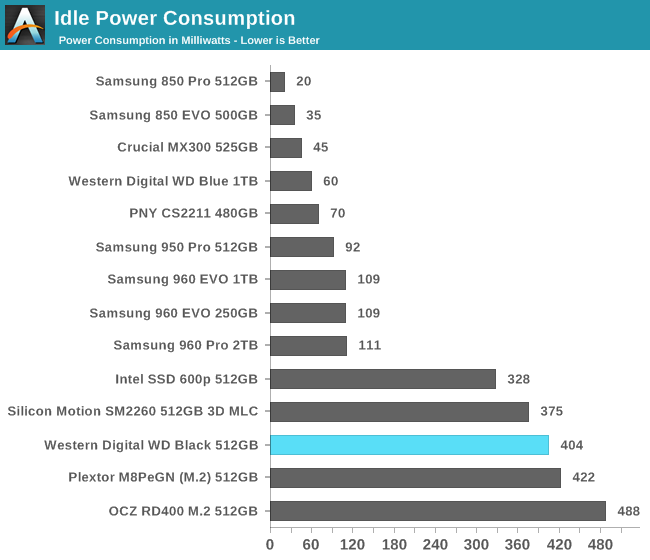
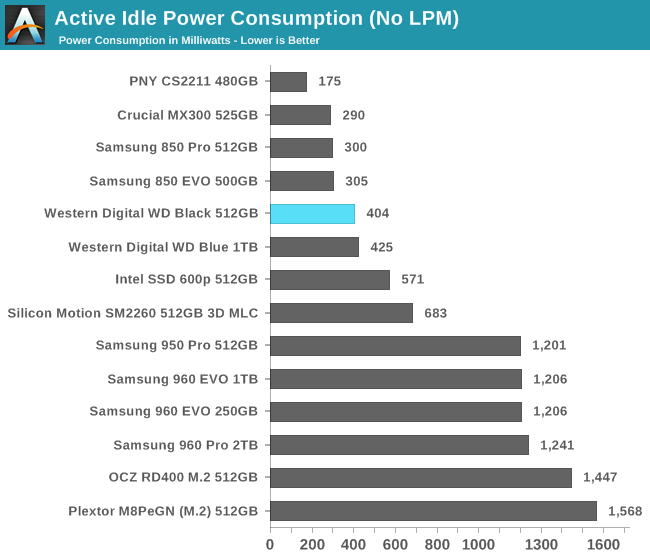
Western Digital has done something unusual with idle power management on the WD Black. On most NVMe SSDs, idle power consumption is quite bad unless the operating system specifically requests that the drive enter a low power state, or if the OS gives the drive permission to use the NVMe autonomous power state transition (APST) feature. The WD Black seems to use an equivalent to APST even if that feature is not turned on by the OS. The reason why APST usually requires OS intervention to enable is that it gives the OS the opportunity to inform the SSD of how much latency is acceptable when waking up from a low power state, and how long the drive should sit idle before dropping down to a lower power state that will take longer to wake up from. (Recall that NVMe SSDs can define many power states, where SATA drives are effectively limited to just two, or three on platforms that support DevSleep.)
When a drive chooses to use autonomous power savings even if the OS doesn't ask for it, the drive should ensure that it does not subject the user to unreasonable wakeup latencies. The WD Black waits several seconds before entering its low-power mode and the wakeup delay is imperceptible, so Western Digital has made a reasonable compromise. The WD Black has better idle power management than any other NVMe SSD when used with NVMe drivers that do not make use of the more advanced power management features NVMe offers. This scenario probably applies to most desktops.
I did encounter one glitch with the WD Black's power management: the deepest power state it supports does not function properly unless PCIe ASPM is also enabled, and our current testbed does not properly support ASPM. Thus, if you're running Linux and manually messing with power states you can end up causing the WD Black to draw more power than the intermediate sleep states. But it's impossible to trigger this behavior on a system that has working PCIe ASPM, or under Windows, or when using NVMe APST instead of manually selecting power states.
Ultimately, power management for PCIe SSDs is still a source of trouble, and the WD Black's low-power states are nowhere near as effective as Samsung's. But the WD Black does deliver an enormous improvement in typical desktop idle power usage over the Plextor M8Pe, despite both drives using the same Marvell controller.










36 Comments
View All Comments
dgingeri - Wednesday, March 8, 2017 - link
At least they priced it about right. It's more expensive than the Intel 600p, but far less expensive than the 960 EVO and slightly less expensive than the M8Pe. This part of the market is odd. Usually, the fastest performing parts are FAR more expensive for just a small return on performance. In SSDs right now, the differences in price are fairly small, but the differences in performance are huge. I think the 960 EVO is about the best deal for a SSD, and this thing is just a shame to the "Black" label.Guspaz - Wednesday, March 8, 2017 - link
So, the product called "WD Black" is coloured blue, but there is also a "WD Blue" product? Let me guess, that one has a black PCB?Gasaraki88 - Wednesday, March 8, 2017 - link
Nope, it would have made sense if they spent the money to use a black pcb for the black drive, a blue pcb for the blue drive and the green pcb for the green drive. Nope.This drive gives the "Black" label a bad name anyway.
MrSpadge - Wednesday, March 8, 2017 - link
They probably thought "our Black HDDs are really slow nowadays, with all those budget SSDs around, so let's call a barely-not-too-slow SSD: BLACK".madspartus - Wednesday, March 8, 2017 - link
WD Black: planar 15 nm TLC NANDI'll be sure to remember that WD doesn't give a shit about the quality and performance of their products and branding. Way to dilute the brand, hope the short term gains are worth it.
shabby - Wednesday, March 8, 2017 - link
The branding is fine, the wd green ssd will be a qlc nand drive.bug77 - Thursday, March 9, 2017 - link
True, black has always been the performance line, it shouldn't go on any TLC parts. Not even on 3D TLC.romrunning - Wednesday, March 8, 2017 - link
On your Storage Bench - Light (Latency) graph, you show the Intel 750 and Patriot Hellfire on top despite the Samsung drives beating them both in "Full" condition. So if they tie on the empty drive score, the Samsungs should be on top due to their full drive latency.Gasaraki88 - Wednesday, March 8, 2017 - link
How come you didn't test any drives that use the Phison E7 controllers? Patriot Hellfire, MyDigitalSSD BPX, and Corsair Force?BrokenCrayons - Wednesday, March 8, 2017 - link
This certainly isn't an impressive product.